- Joined
- Nov 24, 2015
- Messages
- 61
- Reaction score
- 97
- Golden Thread
- 0
- Primary Interest:
- All Treasure Hunting
Dear Members,
Many of us are already aware of the problem of a lack of documentation of pottery of the Great Plains tribes including the Cheyenne. And, as many were nomadic people, pottery was probably not very useful due to the fragile nature of it . When the tribes moved to a new location in search of say buffalo, the pottery could simply break so it is rarely found today. And only as a matter of conjecture, most of any of the pottery would have been made for a special use.
The lack of documentation on the pottery of these people led me to make comparisons of the complex nature of the artwork of the present example to other disciplines of textile art of of the Great Plains tribes. For example, the blackened green stripes around the jar, can also be found in some parfleches. Below is such an example with a blackened green stripe on a Sioux parfleche as can similarly seen in blackened green bands of the jar
And, also as a matter of conjecture, the complex nature of the artwork would have been done in keeping with a complex and great Native Society
Cheyenne Warring Societies theme
The pottery of the Great Plains tribes was typically made from a lump of clay, rather than the coil method as had been used by other tribes. One can see that the interior was “scooped” out from the “lump” in the Great Plains manner, with possibly some influence showing in the shape as might have been learned from Mexican neighbors of the Cheyenne to the south
The complex geometric motif implementing the number 4 in the pattern with fine blackish lines is commonly found in the decorative arts of the Great Plains tribes
The value of the jar comes by a literal interpretation on all of the symbolism employed in the design arrangement- The military theme would be of a military nation origin, one that was concerned with maintaining balance with power in unity of its segments of people used to protect a life of harmony within its borders, a great Native American spiritual goal of the military unit
Symbolism:
The choice of geometric shapes, triangles and stripes and colors, in the repeating pattern, six sets in all shows a great deal of symbolism for interpretation in the context of a warring theme of a great Native American nation organized as a military unit with the central theme of maintaining balance and harmony for its people
The ceremonial jar was painted in both war paint colors, and in a color that was used to convey a message of harmony
The war paints yellow, orange and deep red with only traces of red remaining on the smaller stripes show ones willingness to fight fiercely till death in battle. Black is symbolic of strength and power but it can also mean victory as face paint rather than war paint
A Native American belief held that the wearer of triangles and stripes when drawn in war paints would have supernatural powers bestowed upon them in battle.
The greenish tone color of the neatly laid out borders to the north, south and between each set conveys a message of harmony with the power to maintain it as signified by the black tones
The 4 larger and smaller triangles, point in all directions. The number 4 also denotes completeness in all of the directions, having 8 in all would compound the strength in symbolism
The repeating pattern of sets forms a well drawn circle, each set represents 1 of the warrior societies of the Cheyenne Nation, such as the Dog Soldiers, and all segments were made exactly the same to show none were above or to be treated differently from the others. The six societies together complete the circle signifying unity among them in the struggle to maintain balance and harmony
H: approximately 7 1/2"
Condition: much of the burnishing has worn away, paint losses, slight cracking
Thank you for your comments
Kind regards
Kevin
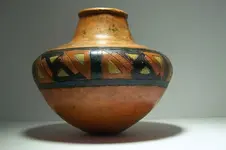
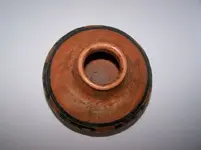
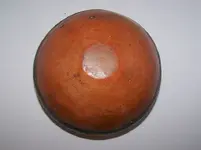
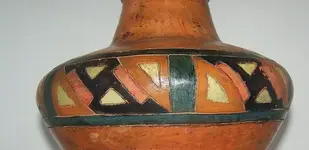
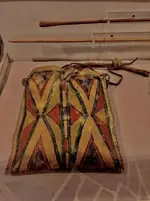
Many of us are already aware of the problem of a lack of documentation of pottery of the Great Plains tribes including the Cheyenne. And, as many were nomadic people, pottery was probably not very useful due to the fragile nature of it . When the tribes moved to a new location in search of say buffalo, the pottery could simply break so it is rarely found today. And only as a matter of conjecture, most of any of the pottery would have been made for a special use.
The lack of documentation on the pottery of these people led me to make comparisons of the complex nature of the artwork of the present example to other disciplines of textile art of of the Great Plains tribes. For example, the blackened green stripes around the jar, can also be found in some parfleches. Below is such an example with a blackened green stripe on a Sioux parfleche as can similarly seen in blackened green bands of the jar
And, also as a matter of conjecture, the complex nature of the artwork would have been done in keeping with a complex and great Native Society
Cheyenne Warring Societies theme
The pottery of the Great Plains tribes was typically made from a lump of clay, rather than the coil method as had been used by other tribes. One can see that the interior was “scooped” out from the “lump” in the Great Plains manner, with possibly some influence showing in the shape as might have been learned from Mexican neighbors of the Cheyenne to the south
The complex geometric motif implementing the number 4 in the pattern with fine blackish lines is commonly found in the decorative arts of the Great Plains tribes
The value of the jar comes by a literal interpretation on all of the symbolism employed in the design arrangement- The military theme would be of a military nation origin, one that was concerned with maintaining balance with power in unity of its segments of people used to protect a life of harmony within its borders, a great Native American spiritual goal of the military unit
Symbolism:
The choice of geometric shapes, triangles and stripes and colors, in the repeating pattern, six sets in all shows a great deal of symbolism for interpretation in the context of a warring theme of a great Native American nation organized as a military unit with the central theme of maintaining balance and harmony for its people
The ceremonial jar was painted in both war paint colors, and in a color that was used to convey a message of harmony
The war paints yellow, orange and deep red with only traces of red remaining on the smaller stripes show ones willingness to fight fiercely till death in battle. Black is symbolic of strength and power but it can also mean victory as face paint rather than war paint
A Native American belief held that the wearer of triangles and stripes when drawn in war paints would have supernatural powers bestowed upon them in battle.
The greenish tone color of the neatly laid out borders to the north, south and between each set conveys a message of harmony with the power to maintain it as signified by the black tones
The 4 larger and smaller triangles, point in all directions. The number 4 also denotes completeness in all of the directions, having 8 in all would compound the strength in symbolism
The repeating pattern of sets forms a well drawn circle, each set represents 1 of the warrior societies of the Cheyenne Nation, such as the Dog Soldiers, and all segments were made exactly the same to show none were above or to be treated differently from the others. The six societies together complete the circle signifying unity among them in the struggle to maintain balance and harmony
H: approximately 7 1/2"
Condition: much of the burnishing has worn away, paint losses, slight cracking
Thank you for your comments
Kind regards
Kevin





Last edited:
Upvote
5






